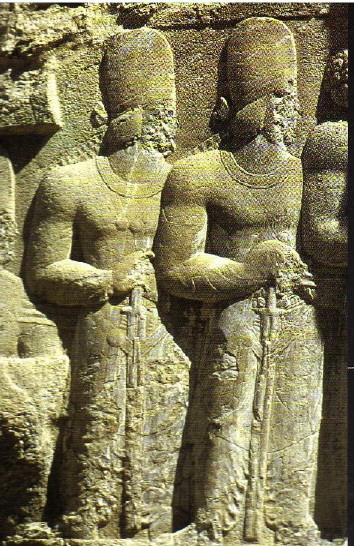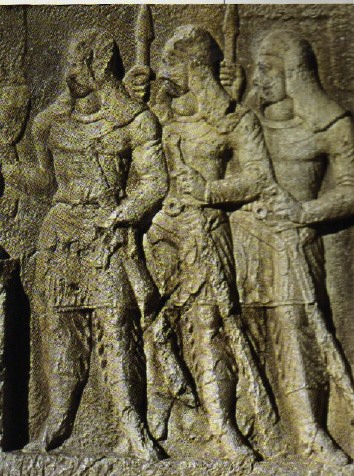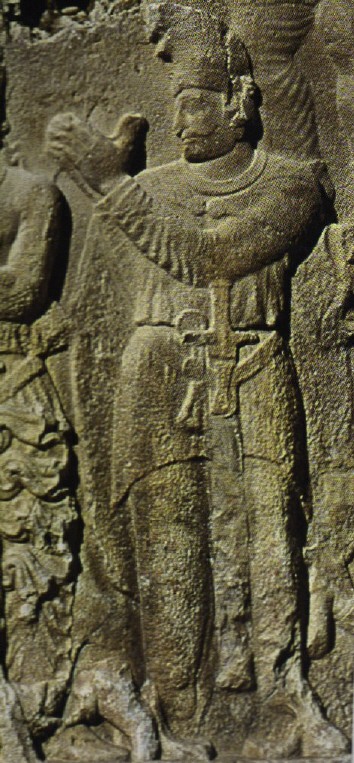Posts: 1,220 Location: Cork, Ireland
Thu 04 Nov, 2010 5:23 am
| Paul Hansen wrote: |
| Thanks for the pictures! There are some more interesting swords at the same page in Flickr. Like I said in the Visigoth thread, I'm not sure that the way they layed the parts out is correct. For instance, the "pommel" seems like a sword hanger to me... |
I'll have to agree with you on this one, something definately seems off about the way they laid out the fittings.
Posts: 1,220 Location: Cork, Ireland
Thu 04 Nov, 2010 9:12 am
| Paul Hansen wrote: |
| Anyway, it seems that the crucible steel used in these blades is not superior to the other types of blade making. Not in terms of hardness anyway. |
Do you know if any of the swords tested were decorated with precious metals and stones, I ask because these were more likely to belong to very wealthy individuals and could have been better quality, as opposed to the more plain swords which belonged to less wealthy individuals, which could have been pretty crappy
Posts: 1,504 Location: Brisbane, Australia
Thu 04 Nov, 2010 1:41 pm
| Stephen Curtin wrote: |
| Paul Hansen wrote: | | Anyway, it seems that the crucible steel used in these blades is not superior to the other types of blade making. Not in terms of hardness anyway. |
Do you know if any of the swords tested were decorated with precious metals and stones, I ask because these were more likely to belong to very wealthy individuals and could have been better quality, as opposed to the more plain swords which belonged to less wealthy individuals, which could have been pretty crappy |
The paper isn't very clear as to where the samples were taken. "Near the handle".
KIS#1 is decorated (gold?). KIS#2 is very corroded, no remaining sign of decoration in the picture in the paper. KIS#1 is harder than KIS#2.
The blades are identified as crucible steel on the basis of low-slag and uniform carbon content. Carbon content isn't reported here.
For more, I'd consider looking in Feuerbach's thesis. I don't have a copy, so I haven't looked.
Yes, it isn't very hard. (Neither is KIS#1.)
Posts: 2,307 Location: Croatia
Fri 05 Nov, 2010 3:49 am
I think taking samples from the blade area near the handle might not be a good idea. That area may intentionally be left softer to absorb shocks than areas nearer the tip that would see more cutting and sharpening.
Posts: 845 Location: The Netherlands
Sat 06 Nov, 2010 7:31 am
Another thing to consider, as mentioned in the introduction, some swords are badly corroded, so the sample taken is from the core of the blade, which would be less influenced by carburisation (and perhaps hardening).
Posts: 490 Location: UK
Thu 11 Nov, 2010 1:53 pm
Migration age sword
Hi
I can't throw any further light on the sword posted that started this thread, but while searching online for images of the two Hunnic swords from Pannonhalma Hungary and dated to the second quarter of the fifth century I came across this interesting pdf which has an image of one the swords on plate 14.The swords are kept at the Xantus Janus Museum Szcechenyi Hungary.
http://eprints.nbu.bg/418/1/Gold-as-INSIGNIA-2.pdf
best
Dave
Posts: 200 Location: Hungary
Wed 16 Mar, 2011 3:15 pm
Re: Migration Period Sword
| A. Fleet wrote: |
| I was recently searching the internet and came across this page: http://www.royalathena.com/PAGES/MigrationMed...L0901.html depicting a migration period sword that seems unlike any of this period I have ever seen. Based on the museum display cited on the page I would assume it is a hunnic sword but alas, I have no images of any hunnic swords for a point of reference. Anyone know what this might be? |
I found similar swords on one of the reliefs of I. Shabur. ( arround 270 AD) I'll scan them next weekend.
Zoltán
Posts: 845 Location: The Netherlands
Thu 17 Mar, 2011 2:15 pm
Re: Migration Period Sword
| Henrik Zoltan Toth wrote: |
| A. Fleet wrote: | | I was recently searching the internet and came across this page: http://www.royalathena.com/PAGES/MigrationMed...L0901.html depicting a migration period sword that seems unlike any of this period I have ever seen. Based on the museum display cited on the page I would assume it is a hunnic sword but alas, I have no images of any hunnic swords for a point of reference. Anyone know what this might be? |
I found similar swords on one of the reliefs of I. Shabur. ( arround 270 AD) I'll scan them next weekend.
Zoltán |
Sounds interesting! I'm looking forward to them.
Posts: 200 Location: Hungary
Sun 20 Mar, 2011 3:00 am
Posts: 1,220 Location: Cork, Ireland
Sun 20 Mar, 2011 3:31 am
Hi Henrik and thanks for adding these pics. It's interesting to note that the reliefs show scabbards with scabbard slides rather than the P shaped mounts, I guess that these must have been a later trend.
Posts: 200 Location: Hungary
Sun 20 Mar, 2011 11:16 am
Yes, the two swords are from the 4-6th Century, the reliefs from arround 270 AD.
Zoltán
Posts: 845 Location: The Netherlands
Tue 12 Apr, 2011 12:30 pm
Thanks for this addition Zoltán!
Where did you get the first picture from?
Posts: 1 Location: USA
Fri 15 Apr, 2011 3:50 am
Excellent discussion which suggests to me a fundamental question: is a "Hunnish" sword a sword made by Huns, a sword made by locals commissioned by Huns or a sword Huns used. Each post is dependent on which of these possibilities, alone or in combination focuses a given post. The references go far in addressing the question. I wonder if the discussion may be helped by explicitly stating which of these three possibilities are being assumed in each post. For example: the speed of a spurt of migration could determine if it was easier to use a plundered local weapon vs having one made.
Posts: 845 Location: The Netherlands
Sun 17 Apr, 2011 10:57 am
| Carl Rosenberg wrote: |
| is a "Hunnish" sword a sword made by Huns, a sword made by locals commissioned by Huns or a sword Huns used. Each post is dependent on which of these possibilities, alone or in combination focuses a given post. |
The Hunnish sword (long, narrow, double edged, iron guard) type is unique enough in Europe to identify graves with them in it, as belonging to the Hunnish confederation. This sword-type originated probably in the East, either on the steppe, in China, in Persia or somewhere in between. But not in Western or Central Europe.
The Hunnish confederation probably consisted of a variety of ethnic groups, some Asian, but others from a variety of European tribes, and to a large extent the "Europeans" adopted "Asian" arms and culture. Definitely not the other way around. Anyway it's very hard to identify graves by ethnicity compared to identifying them by material culture.
Whether the Hunnish swords were made by Huns themselves or by others employed or enslaved by them is I think not so important. But the vast majority of graves identified as Hunnish have Hun-type swords rather than, say, Roman-type swords. In fact, I can't think of any Hunnish find with a Roman sword inside.
| Carl Rosenberg wrote: |
| For example: the speed of a spurt of migration could determine if it was easier to use a plundered local weapon vs having one made. |
That would be more an issue for the peoples who were overrun by the Huns than for the Huns themselves.
You
cannot post new topics in this forum
You
cannot reply to topics in this forum
You
cannot edit your posts in this forum
You
cannot delete your posts in this forum
You
cannot vote in polls in this forum
You
cannot attach files in this forum
You
can download files in this forum



